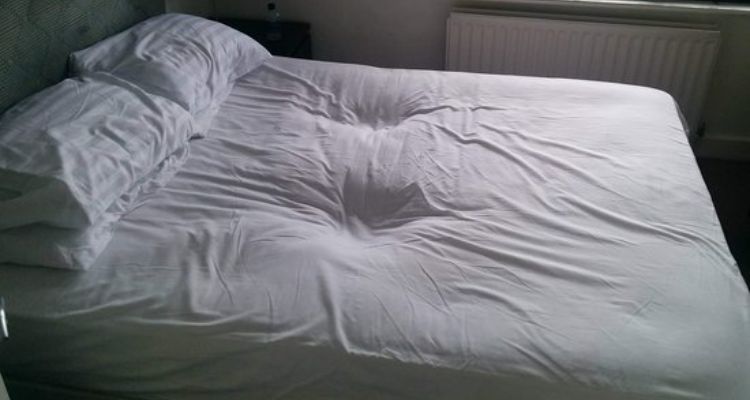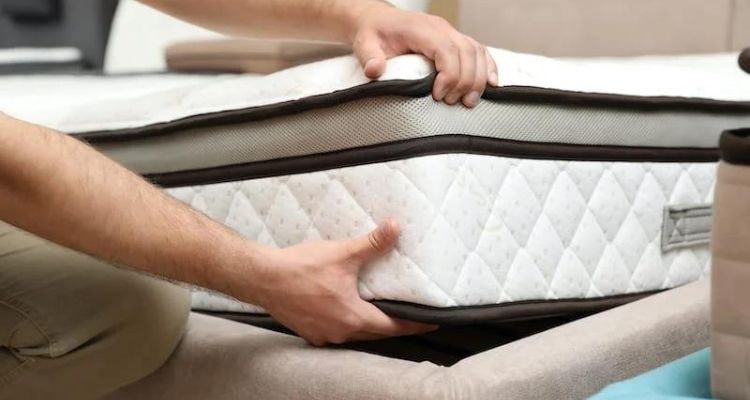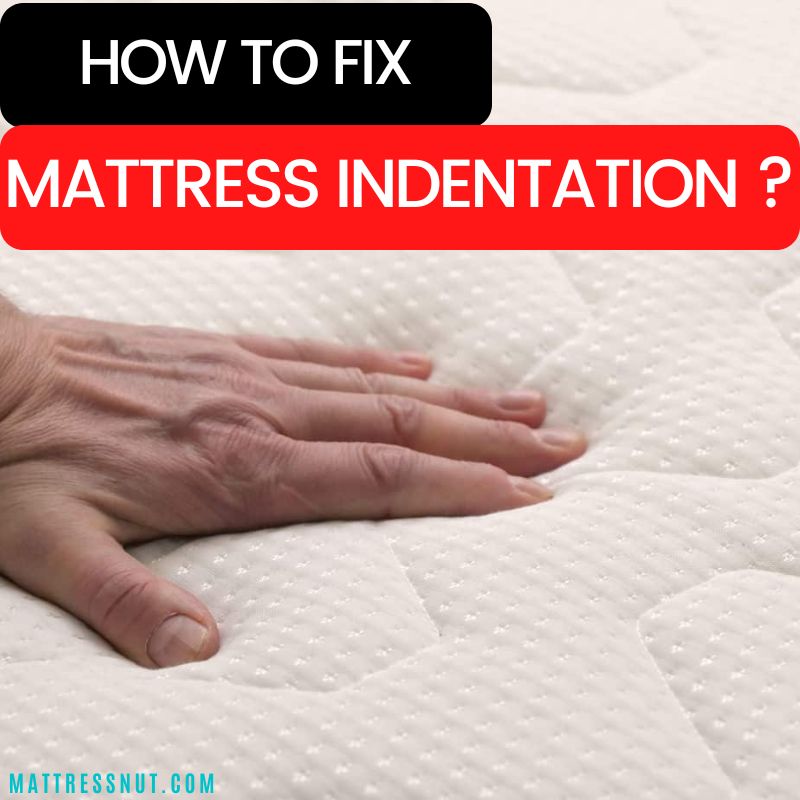Mattresses are designed to provide support and comfort to your body. They support your spine and joints and comfort your muscles as you sleep (also check 10 mattresses with great comfort).
When a mattress starts sagging or develops indentation, your body is no longer in a properly aligned position, and your bed at night feels uncomfortable. As a result, you might feel pain when you get up in the morning (also check 10 amazing mattresses for back pain).
If this pain prolongs or you continue to sleep on such a mattress, it can cause serious health consequences. But the good thing is that there are a few ways to fix or temporarily patch up these indentations and sagging till you buy a new mattress.
Let’s find out how you can achieve that.
Body Impressions, Sagging & Indentations
Irrespective of the material quality and design, all mattresses are prone to wear and tear over time. But there is a huge difference between regular aging and defects or damage.
Regular mattress damages include stains, punctures, and rips. This guide is about bigger issues such as defects affecting a mattress’s support system and integrity.
In terms of structural damage, people confuse and use different terminologies interchangeably, which is wrong. These terms include likes of body impressions, mattress indentations, and mattress sagging (also check 10 best selling toppers for sagging mattress).

What are body impressions?
These impressions form on your mattress naturally, and you will notice them more on mattresses that are softer at the tops and have a conforming comfort layer. This is because these impressions only influence the top layer of a mattress. However, there can be a problem if they develop deep enough and make your spine misaligned.
What are mattress indentations?
In simpler words, you can refer to these indentations as divots or dents in your mattress. These are valleys or potholes that are there in your bed. They are commonly referred to as sagging or indentations.
Nevertheless, there is a slight difference between these two terms. Mattress indentations are spots in your mattress that sunken in; however, sagging is more about the entire mattress.
What is mattress sagging?
Mattresses tend to develop noticeable dips over a larger position, and it is called sagging. They begin to sag, especially where the heaviest parts of our body rest on them (also check 10 great mattresses for overweight person).
It means they sag from the areas where your shoulders and hips rest on the bed. Mattress manufacturers define substantial sagging at a particular depth for various warranty purposes, ranging from 1 to 1.5 inches.
What Causes Mattress Indentations & Sagging?
Even the strongest mattresses eventually start to sag with regular wear and tear. With some stronger materials like latex (super durable), a mattress can last up to 20 years and not develop any particular sag or indentations.
Some mattress materials are more prone to develop these protrusions over time than others. In general, this sagging and indentation can occur due to:
- Imbalanced weight distribution.
- Prolonged usage.
- Inadequate maintenance and care.
- A mattress is paired with a low-quality or improper foundation.
What Type of Mattress Is Least Likely to Sag?
Following are the mattress types and the details about how prone they are to sagging:
Coil spring mattresses
Coil spring mattresses tend to sag within a couple of years because low-quality coils can corrode and lose their performance with continuous use. However, they can last up to 5 years at maximum.
Memory foam mattresses
These mattresses tend to sag in about 1 to 3 years as they have chemicals that can trap heat. It can result in slow responsiveness and sagging over time. However, they can last up to 10 years at maximum.
Latex mattresses
These mattresses tend to soften but maintain their bounciness and response and don’t sag for up to 10 years. Natural Talalay Latex tends to last longer as compared to synthetic or Dunlop latex. They can last for up to 20 years at a stretch.
AirFoam mattresses
These mattresses can retain support and pressure relief throughout their lifespan. It means they are resistant to sagging, highly resilient, and free from heat-trapping chemicals. Depending on their regular wear and tear, they can last for more than 10 years.
Ways to Fix Mattress Sagging and Indentations
So, what can be done to solve this sagging and indentation problem in your mattress? Based on the severity of the sag in your mattress, it might be time to go for a new mattress.
You might still be able to get some years out of your mattress by using a few tricks with minor sagging. Maybe by using these tips, you can buy some time until you wait for your new mattress to arrive.

Rotating your mattress
Not rotating your mattress regularly (about 6 months) can cause the formation of indentations around the pressure points on your mattress. It isn’t a permanent solution, but it’s a good start and a quick fix.
The opposite side of your mattress might haven’t sagged if you have never rotated your mattress. So, it’s good practice to rotate your mattress 180 degrees and start fresh.
Adding a mattress topper
This method will allow you to improve your mattress’s overall comfort and works with any mattress type. So, using a mattress topper can help prevent sagging and indention in your mattress. Therefore, you should use it with your new mattress as well.
Doing so will create an even mattress, and it will provide additional support while extending the overall lifespan of the mattress as well. Moreover, you can consider going for different types of toppers to make your sleep surface more contouring or supportive based on your sleep preferences.
Vacuuming the mattress for redistribution of its filling
This method is an excellent option while working for lumpy or pillow-top mattresses. Just vacuum the surface of your mattress, and you can redistribute its filling and smoothen out its top layer. Doing so will level out its lumps and fill in those indentations.
Placing pillows under the mattress
This technique will help you deal with indentations that are more isolated. Pulling the old pillow track might work if your mattress has a significant bow. But use it as a temporary solution and a spot treatment for those divots. Just locate the indentation and slide a flat pillow in.
Using plywood for reinforcing the mattress frame or foundation
Maybe you have a faulty base, directly contributing to sagging the mattress. These foundations and frames are for a flat surface on which you place your mattress. Now, a sturdy base assists in supporting your body weight and reduces the overall sag that results from prolonged usage.
If this base is not even or not sturdy enough, the mattress will tend to sink, and it will cause pains and aches in your body. Your mattresses stay clean and safe with these bases as they are not in direct contact with the floor.
You will need a new mattress base if the current one cannot support the mattress’s weight. Readjusting those slats (if you have any) can work, or you may place a sheet of plywood in your current foundation to make it work.
How to Prevent Mattress Indentations and Sagging?
You might have decided to fix the sag problem with your existing (old) mattress or have bought a new one altogether. Going for one of the above methods is a good option. Indeed, you would want to prevent indentations and sagging from happening at all.
So, here are a few ways you can use to manage that effectively.
- Make sure you rotate your mattress every 6 months based on the type of materials used in the construction of your mattress.
- Using a mattress topper with your mattress will always keep your mattress clean if you have pets and children in your house. Plus, you can alter your mattress’s overall support and conformance according to your preferences by using a mattress topper.
- Always go for a quality mattress base. Whether you are looking to buy a mattress frame or a foundation, never go for a cheap quality option; else, you will suffer in the long run.
- Using a mattress protector is another good option that you can consider. It will protect your mattress from spills or stains that can cause mold and bacteria. As a result, your mattress will lose its shape faster, and a mattress protector can prevent that from happening.
- Make sure that you keep your bed clean and wash those sheets regularly. And don’t forget to spot clean those spills and stains.
What Is It Time to Say Your Mattress Goodbye?
You have to keep in mind that the techniques that we have mentioned above tend to work better with newer mattresses. It’s because you can extract a few more years from your mattress.
Use the above techniques to buy some time before purchasing a new mattress. If these techniques haven’t solved your mattress sagging and indentation problem, it’s time to let it go for good.
Key Takeaways
Importance of a Good Mattress
- Mattresses are designed to provide support and comfort to your body. When a mattress starts sagging or develops indentation, it can lead to discomfort and potential health issues.
Understanding Mattress Issues:
- Body Impressions: These form naturally, especially on softer mattresses. They can become problematic if they’re deep enough to misalign the spine.
- Mattress Indentations: These are divots or dents in the mattress. They’re often referred to as sagging or indentations, but there’s a distinction between the two.
- Mattress Sagging: This refers to noticeable dips over a larger portion of the mattress, especially where the heaviest parts of our body rest.
Causes of Mattress Indentations & Sagging
- Imbalanced weight distribution.
- Prolonged usage.
- Inadequate maintenance and care.
- Using a low-quality or improper foundation.
Types of Mattresses and Their Susceptibility to Sagging:
- Coil Spring Mattresses: Can sag within a few years.
- Memory Foam Mattresses: Might sag in about 1 to 3 years.
- Latex Mattresses: Maintain their shape for up to 10 years or more.
- AirFoam Mattresses: Resistant to sagging and can last for more than 10 years.
Ways to Fix Mattress Sagging and Indentations:
- Rotating Your Mattress: Rotate every 6 months to distribute wear.
- Adding a Mattress Topper: Provides additional support and comfort.
- Vacuuming the Mattress: Helps redistribute its filling and smoothens out the top layer.
- Placing Pillows Under the Mattress: Useful for isolated indentations.
- Using Plywood: Reinforces the mattress frame or foundation.
Prevention Tips
- Rotate your mattress regularly.
- Use a mattress topper.
- Invest in a quality mattress base.
- Use a mattress protector.
- Keep the bed clean and wash sheets regularly.
When to Replace Your Mattress
If the techniques mentioned above don’t resolve the sagging and indentation issues, it might be time to replace the mattress.
Conclusion:
Fixing those indentations in your mattress is important if you are looking for better support. Fortunately, there are some ways to fix this problem.
But if your mattress is sagging prematurely or the indentations are still troubling you even after fixing them, it’s time for you to bring in a new mattress (check the top rated mattresses).
If you don’t do so, prepare yourself for serious health consequences. So, mattress sagging and indentations are no joke, and you must fix them promptly.
Fix mattress indentation FAQs
Can you fix a dip in a mattress?
The dip occurs as the thickness of your mattress is reduced. So to increase the thickness, you need to add a mattress topper, and you will be able to counter the sagging. Ultimately you will get a more even surface and rest peacefully.
What causes a dip in your mattress?
Your mattress breaks down prematurely or results from natural compression caused by body impressions. Body impressions are not deep, so your mattress breaks down if the dents are deep.
How do you remove dents from a mattress?
There are different ways to remove dents from a mattress; we have explained them in the text above. You have the option of rotating your mattress, adding a mattress topper, vacuuming the mattress for redistribution of its filling, placing a pillow underneath your mattress, or using plywood to reinforce the mattress base.

